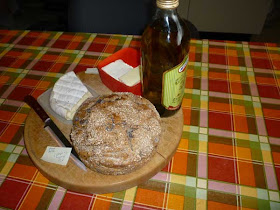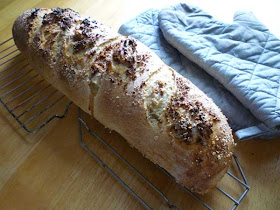Sourdough Bread Made with the Detox Recipe Idea: Rolled up with bran
Before I begin today's bread, I have a confession to make about my ignorance.
How to Degas Dough
There was a time early on when I was learning how to bake bread, that I did not know what it meant to 'Degas' the bread. I assumed it was a French term, perhaps named after a cultural icon in the artisan breadmaking world. Something like the way we name certain things after our cultural icons, for example:
And of course, we in North America might know Edgar Degas as an impressionist artist who liked to use pastels to capture ballerinas, but wasn't he also a famous French artisan bread maker?
Er, no.
So, despite the fact that I still have a lot of bread failures, I am learning things (slowly). To quote Hamelman's
Bread: A Baker's Book of Techniques and Recipes (a recent acquisition for me):
"If the excess of carbon dioxide gas that is generated by the yeast is not periodically expelled, fermentation can be impaired. The degassing function can in fact be achieved by the old 'punching down' method; however, it is more effective when the dough is folded..."
So you see, it is not pronounced '
Degas' the way the French would, but
De-Gas, the way the H'English do. Just thought I'd clear that up for others who were as lost as me. (
What? No one else was that stupid?)
The Last Sourdough This Week
I decided to make the last sourdough bread this week (see
Everyday bread #35 and
#36) using the
Detox Recipe I used a long time ago. In that recipe, I add bran and germ back to the endosperm (all purpose flour), in the same ratio that it was there in the beginning, when it was still wheat.
So if we are using 655 g of total (graham) flour
- 83 percent of that is going to be endosperm or all purpose flour - or 584 g
- 14.5 percent of that is going to be bran - or 96 g
- 2.5 percent of that is going to be wheat germ - or 16 g.
I mixed the bran and wheat germ in a soaker overnight in 1 1/2 cups of milk; I didn't think that any less than that would actually get the entire quantity moist enough.
Ordinarily, by taking that much hydration away from the recipe, this means I only have 1/4 cup to hydrate the rest of the flour, following Reinhart's recipe -- but there's no way that's going to work, so I decided I'd just have to play it by ear. I figured it should probably take at least 1 1/3 c water, and I had that amount ready. But it was coming together with about 1 cup of water, so I set aside 1/3 of a cup that I didn't use.
This dough was not nearly as gloppy as the day's previous, and I am wondering to myself whether I should have just gone for the full hydration I expected to use. On the other hand, even the small amount of whole wheat flour in this mix caused the gluten sheath to tear as I kneaded it. I had to be a whole lot more gentle with kneading this dough.
Remember, I have not yet added the bran and wheat germ to the mix -- I will simply roll that up inside the white dough after it has risen in the bulk fermentation stage. This dough is tearing apart from the
smallest amount of whole wheat from the motherstarter that was there
before the elaboration into the sourdough starter that I'll be using today.
Which leads me to suspect that
rye motherstarters will be better to leaven sourdough breads that have only all purpose flour, since they will make a silkier dough without any sharp bran to catch on the forming gluten strands.
I have to say, though, that mixing this up by hand gave off the most marvellous aroma. The sourdough starter had been cut up and tossed into the flour a couple of hours earlier, and I could see it was already starting to ferment the flour and expand a bit where it was touching, even in the time it had taken to come to room temperature, and even without hydration.
Remember, this starter was mixed and had risen several days ago, prior to being refrigerated. The texts say that you then have to use it within 24 hours. But it has been a lot longer than that, for this final sourdough starter -- 4 days refrigerated. The scent is not a sour scent. It is woodsy, kind of nutty. I really don't have the vocabulary to describe it, but it smells alive and fresh.
But would it still be able to rise my dough?
Yes. In about 2 1/2 hours, it was noticeably bigger. I am always amazed at this. I get so excited. I love found food. It is better than going to your garden and getting it. This leaven didn't cost me anything, really. I found it on the flour, I found it in the air. It just appeared.
No yeast, ma! No yeast!
I flattened the dough out on the countertop (this degassed it!), to a more-or-less rectangular shape. I dumped the soaked bran and germ on top, and smoothed it all out. It was a lot more crumbly than I remember it. Did I use yogurt last time? Did I incorporate more of the flour? Why was the consistency different?
Undaunted, I smoothed it out and rolled it up as tightly as the gluten would allow.
A bit of milky bran oozed out and rather than trying to stuff it back inside, I just sprinkled it on top (along with a little bit of extra cracked wheat). I shored up the sides of the couche with the nearest long cylindrical objects I could find. Then I covered it for a couple of hours, hoping it would rise and not spread and sag.
It held together nicely, retaining its shape and plumping up the way it should, without oozing sideways. And it baked up impressively, too, filling in my score marks for the most part (oozing a bit of milk from the slits as it baked). The bran on the top was probably a mistake: it looks like it all burnt, despite its milkiness, and it will taste pretty roasted and bitter, no doubt.
Although I thought I was extra careful
not to make the loaf long, this bread was still a tiny bit too horizontal for my baking stone, and drooped a bit off either end, although I am pleased with how I centered it and pushed it into place without deflating it or munging it too badly. (I used a metal pizza peel to scoop the proofed dough off the couche, then I pushed the loaf off the peel onto the baking stone with my free hand. Then I corrected some dough wobble before shutting the door on the baking loaf.)
Probably the ends are going to be a little too cooked. They look somewhat dry.
I had this bread in the oven at 475 degrees F. for ten minutes, then I turned it, and after 10 minutes I turned it 45 degrees for another 5 minutes. Because it was oozing milk at the 20 minute mark, I opted for the extra 5 minutes, afraid it would not be cooked through.
Crumb shots to follow.
Something interesting happened to this bread the other day when I wanted a slice. There was a funny discoloration and I took a whiff: definitely a fungus growth. And it was growing on the bran/germ, but infiltrating into the white bread. I have never had a bread go stale and grow bread mold this quickly before, not ever. I am not sure why it happened, but it seems clear that it came from the milk-soaked bran and germ. Now that I think about it, the soaker should have been in the refrigerator overnight, instead of out on the counter. Probably the milk spoiled because of it.
The chickens ended up with half of this loaf.
Notes to Myself:
- Be extra vigilant in not making your loaves longer than the baking stone! Allow for some lengthwise expansion during the bulk fermentation or rising stages.
- That couche idea worked well to shore up the sides of this loaf while it was proofing. Of course, the way this dough is formed also has a lot to do with its tightness. And finally, the dough was not too wet.
- Try this with yogurt next time, rather than milk. Go fermentation!
- Keep soakers overnight in the refrigerator


























































